Via Inhabitat:
Lot-Ek in their presentation talks about the reuse of container for homes. The house will be from container that is cut in their sides of corrogated metal for windows and doors. The interior will be covered with wall boards and ceiling boards.
contemporary modern architecture
Sunday, July 27, 2008
Container houses by Lot-Ek
Posted by Probo Hindarto at Sunday, July 27, 2008 0 comments
Labels: architect, building methods, green architecture, prefab houses
Sustainable prefab houses
 The modern house, by Method Homes is a prefab factory-built green homes with a commitment to innovative design and sustainability. They say by building in a factory they will reduce construction waste to less than 10 percent of materials used, compared to 30 percent common in site-built construction. Their factory built process in conjunction with enhanced insulation, solar options, and energy star appliances ensure Method Homes are energy efficient and will save the owner money.
The modern house, by Method Homes is a prefab factory-built green homes with a commitment to innovative design and sustainability. They say by building in a factory they will reduce construction waste to less than 10 percent of materials used, compared to 30 percent common in site-built construction. Their factory built process in conjunction with enhanced insulation, solar options, and energy star appliances ensure Method Homes are energy efficient and will save the owner money.
Method Homes will provide fresh indoor air to inhabitants by offering radiant heat, increased ventilation, and eliminating VOC finishes and other harmful chemicals. The Method Cabin is targeting LEED for homes 2.0 Gold certification.
Posted by Probo Hindarto at Sunday, July 27, 2008 0 comments
Labels: architect, building methods, green architecture, prefab houses, villa
Friday, July 25, 2008
Farming in urban city - winner of green architecture competition
 A chance to farm in urban areas.
A chance to farm in urban areas.
This the winner for green architecture competition. Mithun Architects designed an urban farm building, a building for farming that will produce vegetables, fruits, even chicken farm.
Explained in the website Ecogeek.com:
Some features of the "Center for Urban Agriculture" (CUA):
- Fully self-sufficient building: in energy and water.
- 31,000 sq ft rooftop water rainwater collection
- Recycling of gray water (including an ability to handle some of the surrounding area's waste water up to "20 times its own discharge potential")
- 34,000+ sq ft of solar PV cells with hydrogen gas backup
- "Agricultural features include fields for growing veggies and grains, greenhouses, rooftop gardens and even a chicken farm."
- Local produced food is critical for changing energy patterns as "40 percent of an individual's ecological footprint is generated by the embodied energy in food."
- 318 apartments (studio, 1 & 2 bedroom units)
- Restaurant & Cafe (The "Greenhouse" using building grown food.
Posted by Probo Hindarto at Friday, July 25, 2008 0 comments
Labels: architect, green architecture, urban design
Interior designs by Javabali.info
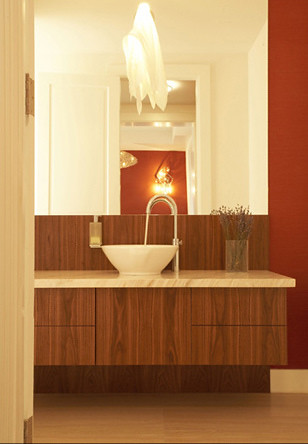
A beautiful simple, yet effective design by javabali, posted in Flickr. This refreshing bathroom set with red color has a floating like shelves. In the works that they post, there are a lot of modern interior design worth to see and give you inspiration.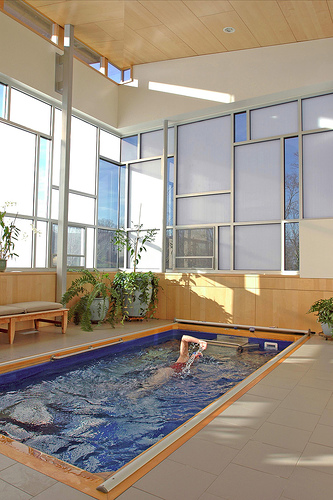
Like the above indoor pool, interesting design with unique windows like cubism painting.
Posted by Probo Hindarto at Friday, July 25, 2008 0 comments
Labels: home accesories, interior design, windows
Interview with Ken Yeang - his vision of future architecture
 In 2003, Yeang's work was included in the exhibition "Big & Green: Towards Sustainable Architecture in the 21st Century" curated by David Gissen at the National Building Museum
In 2003, Yeang's work was included in the exhibition "Big & Green: Towards Sustainable Architecture in the 21st Century" curated by David Gissen at the National Building Museum
Yeang's 1992 Menara Mesiniaga building in Subang Jaya Selangor, Malaysia is a catalogue of his bioclimatic techniques, including daring "vertical landscaping", external louvers to reduce solar heat gain, extensive natural ventilation and lighting, and an "active Intelligent Building" system for automated energy savings.
Like William McDonough, Yeang's concentration on energy conservation and environmental impact is a radical departure from mainstream architecture's view of the profession as an art form. Yeang has written, "In practice, architectural design is a craft, and a variable one at that. Post modernism has successfully shown up the volatile nature of this craft by its unrestrained use of architectural symbolisms, its frivolous multiplication of the surface area of the built envelope, its prodigious use of unnecessary building materials, its indifference to engineering economy, its extravagant use of land, and its irrational subservience to whim and history instead of the allocation and restriction of excessive consumption of energy resources." Yeang is very innovative, and who might know that his original idea can save the world? (Wikipedia with little changes).
INTERVIEW WITH KEN YEANG.
An interview with architect Ken Yeang, on CNN's 'Just Imagine' programme.
Ken describes his vision for the future of buildings - and how we might live in and organise our cities in 2020, to make them greener.
Posted by Probo Hindarto at Friday, July 25, 2008 0 comments
Labels: architect, building methods, urban design
Mobile Performance Venue - Mobile Building that can be put everywhere

on grass...
on water...
on dessert...
The first time I saw this design... It was really interesting because it can stand everywhere and mobile too.
This was posted in Pushpullbar forum, by Jimmern, a PushPullBarian, and an architect in Various Architect, Oslo, Norway. He said:
The following design principles have driven the development of the concept:
- Create a unique, iconic, and sculptural object to house the Identity Of The Soul performance and represent Arts Alliance Productions worldwide
- Design a calm inner space that will enhance the experience of the performance
- Create an exciting and inviting exterior in contrast to the inner surfaces and spaces
- Create a lightweight mobile venue that can be transported in standard shipping containers with quick erection time and set-up onsite
- Design a flexible solution that would suite different locations, sizes, and types performances
- Use durable materials, long lasting with repairable and replaceable parts where possible
Visit the complete explanation about this design here.
Posted by Probo Hindarto at Friday, July 25, 2008 0 comments
Labels: architect, contemporary architecture, museums, prefab houses, public building, urban design
A cozy library corner, with fireplace
 Via thisoldhouse.com
Via thisoldhouse.com
Amazed by this cozy corner, I post this here. A library area with shelves, stone veneer chimney, and windows masked from the street, that feels like a homey space.
The home owner, George Mabry, says he will use the room every day. "I'll have dinner parties," he says. "But I didn't want the room gathering dust the rest of the time."
Very nice room to enjoy the day isn't it? But what if the window can be more open?
Posted by Probo Hindarto at Friday, July 25, 2008 0 comments
Labels: apartments, home accesories, houses, windows
Thursday, July 24, 2008
Meet Tadao Ando
INTERVIEW WITH TADAO ANDO
from http://www.designboom.com/eng/interview/ando.html
http://www.designboom.com/eng/interview/ando.html
what is the best moment of the day?
no particular moment.
morning maybe good because of the feeling of beginning.
what kind of music do you listen to at the moment?
mostly classic.
what books do you have on your bedside table?
I am interested in things happening around me, and I need to understand
what's going on in other artistic sectors like music and literature.
I read a lot, but nothing comes to mind at the moment.
do you read architecture and design magazines?
I don't read them. just look at it.
I assume you notice how women dress.
do you have any preferences?
I don't look so closely at women's fashion, but from the 20th century on,
people have had the freedom to express themselves and their individualities,
and fashion is one of the most fundamental ways in which they do this,
men and women are equally able to express themselves.
what kind of clothes do you avoid wearing?
nothing in particular.
do you have any pets?
a dog named 'le corbusier'.
where do you work on your designs and projects?
once I traveled a lot, to see the nature, the countryside and the cities,
with a sketchbook... a practice I continue today.
but plans actually I draw in my office.
who would you like to design something for?
I believe that the way people live can be directed a little by architecture.
I would like my architecture to inspire people to use their own resources,
to move into the future.
although now we are more and more governed by the american way
of thinking, money, the economy...
I hope that now people will shift to a more european way (of thinking),
culture, individuality, and that people move towards new goals.
so for me to be able to contribute to this would be great.
do you discuss or exchange ideas with other architects?
not much.
describe your style, like a good friend of yours would describe it.
walls are the most basic elements of architecture,
and in all my works, light is an important factor.
the primary reason is to create a place for the individual,
a zone for oneself within society.
its very difficult to explain or describe my style, I hope the answer will
come out of the interview.
what project has given you the most satisfaction?
as an architect you have to do your best work for any project,
but for me the most satisfying thing is when architecture can
do something to make people's lives better, to inspire them.
do you try to find meeting points between asian and european cultures?
I don't see them as opposites, the west and the east,
but for example western society seems to be centered on
american culture.
but I think it is important to understand that apart from that
main culture, there are so many other cultures,
and it is necessary to respect them all and their differences.
is there any architect from the past you admire?
of course I learned from history, from the renaissance,
from mies van der rohe, le corbusier, terragni... many architects.
what current architects do you appreciate?
like with the work of the past, as an architect you have to look around
and see what your contemporaries are creating,
for my contemporaries I have respect and interest.
did you always want to be an architect?
right from the beginning yes, but in my life I have done many things,
at one time I was a boxer...
I was never a good student.
I always preferred learning things on my own.
FROM WIKIPEDIA:
His "Row House in Sumiyoshi" (Azuma House), a small two-story, cast-in-place concrete house completed in 1976, is an early work that begins to show elements of his characteristic style. It consists of three equally sized rectangular volumes: two enclosed volumes of interior spaces separated by an open courtyard. By nature of the courtyard's position between the two interior volumes, it becomes an integral part of the house's circulation system.
Ando's housing complex at Rokko, just outside Kobe, is a complex warren of terraces and balconies and atriums and shafts. The designs for Rokko Housing One (1983) and for Rokko Housing Two (1993) illustrate a range of issues in the traditional architectural vocabulary -- the interplay of solid and void, the alternatives of open and closed, the contrasts of light and darkness. More significantly, Ando's noteworthy achievement in these clustered buildings is site specific -- the structures survived undamaged after the Great Hanshin Earthquake of 1995. New York Times architectural critic Paul Goldberger argues convincingly that "Ando is right in the Japanese tradition: spareness has always been a part of Japanese architecture, at least since the 16th century; [and] it is not for nothing that Frank Lloyd Wright more freely admitted to the influences of Japanese architecture than of anything American." Like Ando, Wright's site specific decision-making anticipated seismic activity; and like Ando's several Hyōgo-Awaji buildings, Wright's Imperial Hotel in Tokyo did survive the Great Kanto Earthquake of 1923.
Posted by Probo Hindarto at Thursday, July 24, 2008 0 comments
Labels: architect, building methods, contemporary architecture
Office building near Lelystadt, The Netherlands
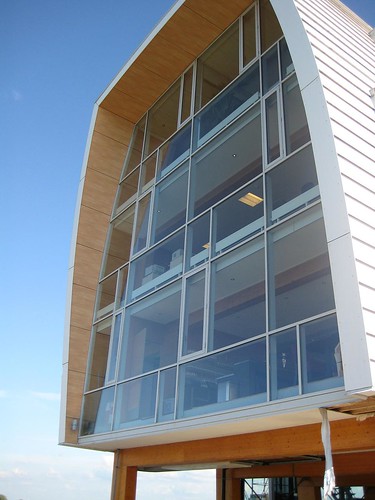
There's no more explanation from _kel_ in Flickr about this building, but "Nothing in particular - the office of a building company near Lelystadt, The Netherlands."
The building is interesting, with wide glass wall on one side and artistic arrangement of the aluminum framing. Interesting work
Posted by Probo Hindarto at Thursday, July 24, 2008 0 comments
Labels: contemporary architecture, windows
Wednesday, July 23, 2008
Modern house design, in Flickr by Jason McMinn

Jason McMinn shows us great series of a contemporary house design in Flickr.

The house is quite simple, but has a lot of beautiful detail. Find new ideas with him.
Posted by Probo Hindarto at Wednesday, July 23, 2008 0 comments
Labels: apartments, contemporary architecture, houses, villa, windows
Museum of Modern Literature in Marbach am Neckar, Germany
 via building.co.uk:
via building.co.uk:
The museum designed by David Chipperfield Architect won the RIBA Stirling Prize.
The museum brings together, for the first time since reunification, texts from a variety of German authors which had previously been dispersed in former East and West Germany.
The judges said: “This is a building that is simultaneously rich and restrained, a trick Chipperfield pulls off as well as any architect working today.
“The architect's control and discrimination in the choice of materials has by now become a signature but above all it is in the handling of the 'difficult whole' that the building excels.”
The judges added: “You can see that every penny spent has been carefully considered but that the right way to do things has always been chosen over the cheapest.“Since the end of the war Germany has been sensitive to matters concerning the neo-classical in architecture. Had it been submitted a decade or two earlier it would surely have been eliminated for its formal manner.”
Posted by Probo Hindarto at Wednesday, July 23, 2008 0 comments
Labels: award, museums, public building
Remote interior designing
 Arthur, a designer from Chicago did this interior design remotely, and measure all space in occasional weekend visits. And the first time he stepped inside the house was after he was done with the interior design without ever stepping inside the house.
Arthur, a designer from Chicago did this interior design remotely, and measure all space in occasional weekend visits. And the first time he stepped inside the house was after he was done with the interior design without ever stepping inside the house.
via ApartmentTherapy.com:
"...the space is so well organized! From a great landing strip with built-in shoe storage, a streamlined home office set up, and compact but fully functioning kitchen to the hands down neatest-closet-ever featured on AT:Chicago, this place simply works. But it is not all about function - the choices of furniture, artwork and all the details that make a house a home are there. The mementos and books and colorful art warm up the crisply designed and outfitted urban space, giving a glimpse of the interests of the owner and making it warm and inviting. A fantastic job, remotely done or not - we think Arthur is rightly proud of his new Chicago home!"
home!"
Posted by Probo Hindarto at Wednesday, July 23, 2008 0 comments
Labels: apartments, furniture, home accesories
3D animation of a house in Lake Havasu, Arizona
3D animation of a house in Lake Havasu, Arizona.
Posted by Probo Hindarto at Wednesday, July 23, 2008 0 comments
Wooden house in Vancouver, Canada
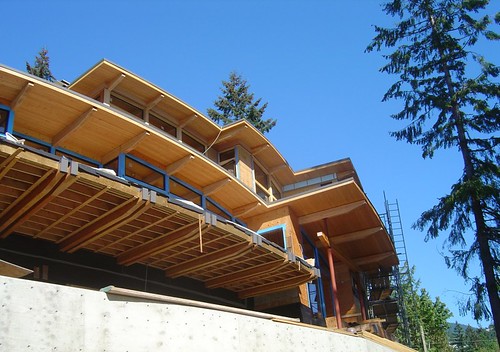
First I saw this house in a book of houses compilation. Quite amazing design of wooden house.
The poster in Flickr said it:
A new modern west coast post and beam style house under construction in the Eagle Harbour neighbourhood of West Vancouver, BC, Canada.
More to see from this house:
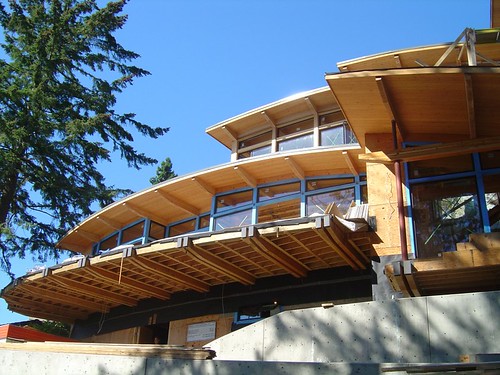
This house is a very good example of wood construction.
Posted by Probo Hindarto at Wednesday, July 23, 2008 0 comments
Labels: building methods, houses, villa
(New House (?) in Paris
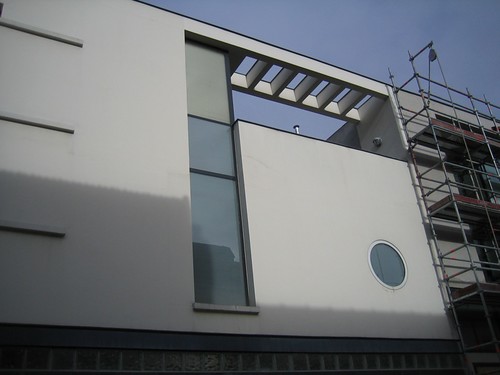
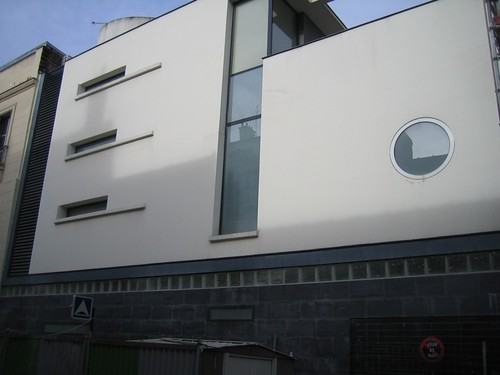
Flickr magical image of a house in Paris (?), I found this in here.
There's no further explanation. But I think this house really show simplicity of geometric forms. There's a Japanese de ja vu in the facade. Don't you think?
Posted by Probo Hindarto at Wednesday, July 23, 2008 0 comments
Labels: apartments, commercial building, contemporary architecture, windows
SHIGERU BAN New York City Shutter Houses
 Via Inhabitat.
Via Inhabitat.
Scaling his literal Curtain House into a larger and more dense development, Shigeru Ban’s Shutter Houses are one part architecture, one part art, and one part pure poetry from one of our favorite thoughtful architects. The 9-unit condo located in West Chelsea blurs the line between indoor and outdoor with a perforated metal shutter system that lets residence open and close their spaces on a whim.
Units range from 1,950 to 3,180-square-feet.  The rolling shutters are inspired by Korean delis and Chelsea galleries that use industrial rolling grates to open and close their storefronts. Shigeru makes industrial chic, and allows urban dwellers to let the sunshine in and live among nature even in the bustling Big Apple. Metal Shutter Houses at 524 West 19th Street are scheduled for completion in Fall 2008.
The rolling shutters are inspired by Korean delis and Chelsea galleries that use industrial rolling grates to open and close their storefronts. Shigeru makes industrial chic, and allows urban dwellers to let the sunshine in and live among nature even in the bustling Big Apple. Metal Shutter Houses at 524 West 19th Street are scheduled for completion in Fall 2008.
Posted by Probo Hindarto at Wednesday, July 23, 2008 0 comments
Labels: apartments, building methods, commercial building, contemporary architecture, windows
Nice 3D rendering
 This building is so quite a temptation for me to post it here, because the sense of clarity in its design as well as the innovative idea.
This building is so quite a temptation for me to post it here, because the sense of clarity in its design as well as the innovative idea.
made by Joel+Maria Pirela in blinkr.net, this design is an inspiration.
Posted by Probo Hindarto at Wednesday, July 23, 2008 0 comments
Labels: contemporary architecture, houses, villa

Labels
- apartments
- architect
- award
- books
- building methods
- commercial building
- contemporary architecture
- furniture
- google streetview collection
- green architecture
- historic
- home accesories
- houses
- interior design
- museums
- prefab houses
- public building
- push pull
- sculpture
- urban design
- villa
- windows
- youtube architecture collection
Blog Archive
-
▼
2008
(47)
-
▼
July
(17)
- Container houses by Lot-Ek
- Sustainable prefab houses
- Farming in urban city - winner of green architectu...
- Interior designs by Javabali.info
- Interview with Ken Yeang - his vision of future ar...
- Mobile Performance Venue - Mobile Building that ca...
- A cozy library corner, with fireplace
- Meet Tadao Ando
- Office building near Lelystadt, The Netherlands
- Modern house design, in Flickr by Jason McMinn
- Museum of Modern Literature in Marbach am Neckar, ...
- Remote interior designing
- 3D animation of a house in Lake Havasu, Arizona
- Wooden house in Vancouver, Canada
- (New House (?) in Paris
- SHIGERU BAN New York City Shutter Houses
- Nice 3D rendering
-
▼
July
(17)
Based on original Visionary template by Justin Tadlock
Visionary Reloaded theme by Blogger Templates




